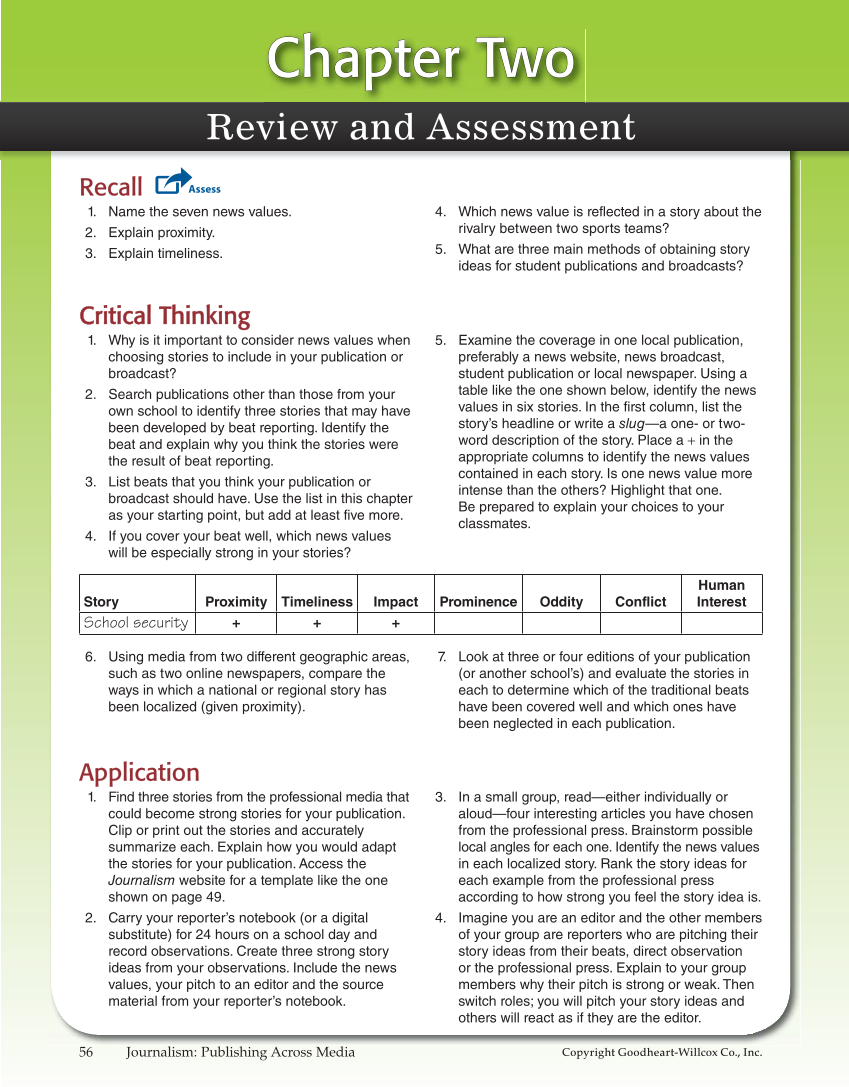Copyright Goodheart-Willcox Co., Inc. 56 Journalism: Publishing Across Media Review and Assessment Chapter Two Chapter Two Application 1. Find three stories from the professional media that could become strong stories for your publication. Clip or print out the stories and accurately summarize each. Explain how you would adapt the stories for your publication. Access the Journalism website for a template like the one shown on page 49. 2. Carry your reporter’s notebook (or a digital substitute) for 24 hours on a school day and record observations. Create three strong story ideas from your observations. Include the news values, your pitch to an editor and the source material from your reporter’s notebook. 3. In a small group, read—either individually or aloud—four interesting articles you have chosen from the professional press. Brainstorm possible local angles for each one. Identify the news values in each localized story. Rank the story ideas for each example from the professional press according to how strong you feel the story idea is. 4. Imagine you are an editor and the other members of your group are reporters who are pitching their story ideas from their beats, direct observation or the professional press. Explain to your group members why their pitch is strong or weak. Then switch roles you will pitch your story ideas and others will react as if they are the editor. Critical Thinking Critical Thinking 1. Why is it important to consider news values when choosing stories to include in your publication or broadcast? 2. Search publications other than those from your own school to identify three stories that may have been developed by beat reporting. Identify the beat and explain why you think the stories were the result of beat reporting. 3. List beats that you think your publication or broadcast should have. Use the list in this chapter as your starting point, but add at least five more. 4. If you cover your beat well, which news values will be especially strong in your stories? 5. Examine the coverage in one local publication, preferably a news website, news broadcast, student publication or local newspaper. Using a table like the one shown below, identify the news values in six stories. In the first column, list the story’s headline or write a slug—a one- or two- word description of the story. Place a + in the appropriate columns to identify the news values contained in each story. Is one news value more intense than the others? Highlight that one. Be prepared to explain your choices to your classmates. 6. Using media from two different geographic areas, such as two online newspapers, compare the ways in which a national or regional story has been localized (given proximity). 7. Look at three or four editions of your publication (or another school’s) and evaluate the stories in each to determine which of the traditional beats have been covered well and which ones have been neglected in each publication. Recall 1. Name the seven news values. 2. Explain proximity. 3. Explain timeliness. 4. Which news value is reflected in a story about the rivalry between two sports teams? 5. What are three main methods of obtaining story ideas for student publications and broadcasts? Assess Story Proximity Timeliness Impact Prominence Oddity Conflict Human Interest School security + + +
